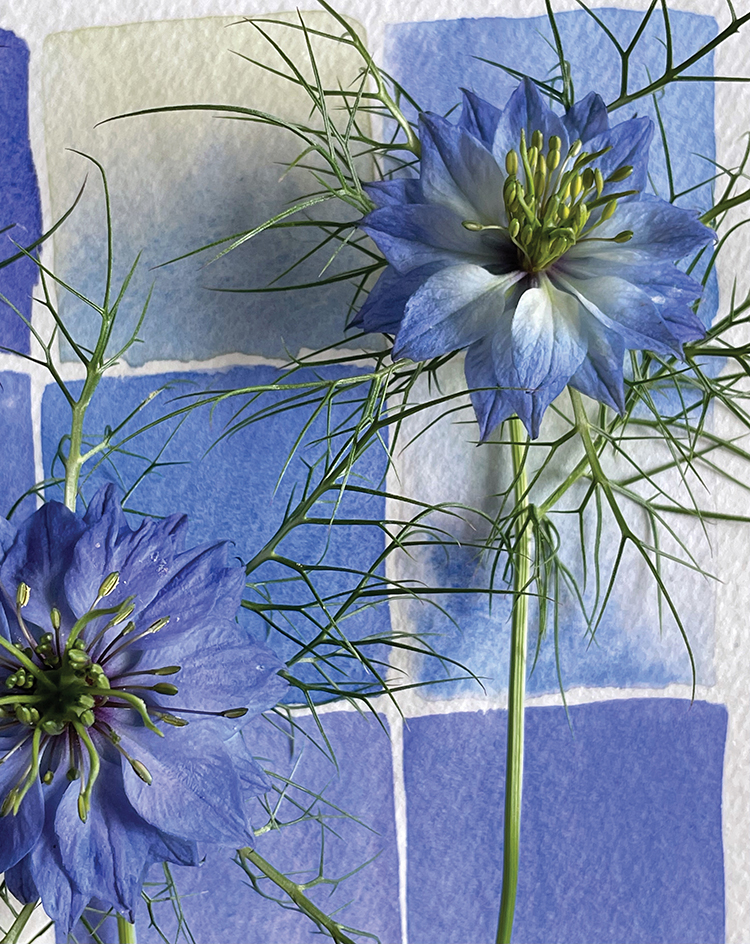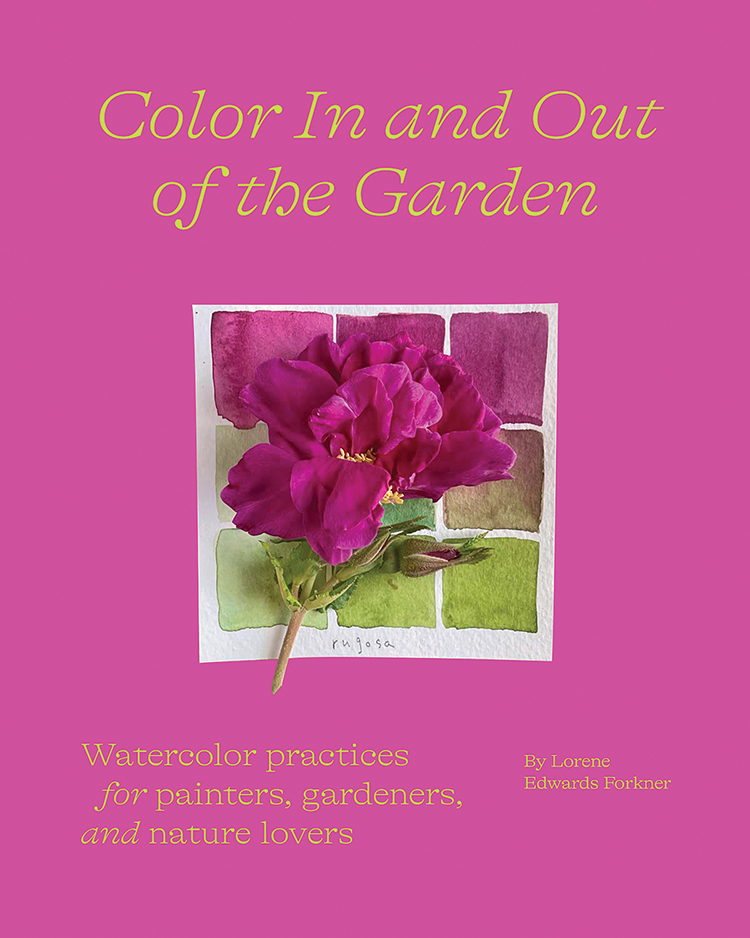
Seeing Color In The Garden
Anything that encourages us to slow down and pay attention is nourishing. I am an artist as well as a writer who gardens and a gardener who writes. All these pursuits require time and tending.
Several years ago, I discovered The 100 Day Project, an annual online challenge where people from all over the world commit to spending 100 days exploring creativity and publicly sharing their efforts. It’s a powerful, global community of encouragement and accountability.
Spring of 2018 was a particularly difficult time: My dad had just died after a long illness; my family was facing health and recovery challenges as well as a shift in our economic security, to say nothing of a toxic political scene. Even though I was a human stew of anxiety, fear and depression, my determination to participate in an online challenge led to the creation of a daily practice that supports me to this day.
Color is seductive. It is both delightful and one of nature’s most sophisticated tools to capture the attention of all living creatures. Along with pollinators searching for pollen and nectar, and hungry animals foraging for ripe fruit, we humans are under the spell of color.

My daily practice is about plants and color and paying attention. It’s about looking out and looking in. Now, nearly five years later, I find I look more expansively at the world around me. It sounds dangerously close to admitting that “I hear voices,” but honestly, I see more than I used to. Noticing reveals the invisible.
“Instructions for living a life. Pay attention. Be astonished. Talk about it.”
— Mary Oliver
Sharing my color studies with others is an important part of my practice, as is my encouragement for people to pick up a brush and play along. But can you teach someone to see more color — what, in fact, is color? According to physics — the branch of science that deals with properties of matter and energy — color is light and vitality. Colors need light to activate their energy; that’s why we can’t see color after dark. Yet here’s the thing: Colors don’t sit still.

Light is fluid, constantly changing by the hour, from season to season and even with regard to where you are in the world. Depending on their placement, colors flow, bounce, vibrate or hum. Especially in a garden where the light is constantly shifting. This makes color slippery, an ever-changing — almost sentient — presence.
“Life is a garden, not a road. We enter and exit through the same gate. Wandering, where we go matters less than what we notice.”
— Kurt Vonnegut
There’s a delightful feedback loop to identifying color. The more we look, the more we see. The more we can distinguish, the greater our ability to discern further detail. It’s as if the generosity of our attention enlarges our perception.

What’s Your Favorite Color?
Typically, a color is defined — by its color. A generally accepted, if somewhat circular, logic lacking scientific rigor, imagination and romance, in my humble opinion. Have you ever tried to remember a color? It’s nearly impossible. But when color, memory and association collide, our fluency with color improves, and for that, we need language. Naming expands and specifies our perception of color.
What’s more, naming colors puts us into a conversation with others. If you say orange, we both probably picture an orange orange. But if you say peach, apricot, tangerine or pumpkin, you’ve helped me to “see” various expressions of what is still basically orange. I collect color names like others collect teacups or trinkets. I never tire of this word game that, along with my color studies, deepens my awareness of nuance.

People shy away from committing to do something every single day. However, I’ve come to believe that the brilliance and the beauty of a daily practice is its constancy and its forgiveness. We always get another chance. People often ask me how I find new subjects to paint. I don’t! I paint the same things over and over. The subject may be the same, but the light is different; I’m different. The Japanese call this ichi-go ichi-e, which can be translated loosely as “for this time only.” Each subject, each breath, each painting captures a once-in-a-lifetime moment.
“Color is the place where our brain and the universe meet.”
— Paul Klee
My color practice is a playful exercise that’s pleasing and grounding. Whether I’m giving a talk, leading a workshop or simply painting side by side with a friend in the garden, color is is my constant companion — even when I travel.

Process
All you need to begin creating color studies are watercolor paints, a brush, a glass of water and a surface on which to mix your colors and paper to paint on. I prefer working with a limited palette of somewhat contrived “paintbox colors” to replicate the more nuanced colors I see in nature.

Look
First, I select a botanical — a sprig, really — like this late-summer seedhead of love-lies bleeding. Placing the subject on a white sheet of paper eliminates distraction and helps me isolate and identify colors.

Mix & Test
Then I start mixing colors and testing swatches on a scrap of paper. Holding my subject up against the test swatches allows me to compare relationships and note how the colors relate to one another, which tells me how close I’m getting to a match.

Record
Once I’m satisfied with a color, I lay down a swatch on my color study grid and move on to the next hue. When finished, I label my painting with the name of the plant or a reference to what I’m thinking about that day. In this way, my color studies are a timestamp of the season as well as a form of memory keeping recorded in color. Finally, once the painting has dried, I place the botanical on top of the grid to see how close I came to capturing the colors and snap a photo with my camera phone.

What began as an attempt to simply show up for an online challenge during a difficult time has since become a part of me. My practice is a way to quiet my mind, even on days when my clumsy attempts frustrate me and fall short of depicting what nature does so elegantly. My paintings are not botanical illustrations but an exercise to improve my ability to see. I often say that I’m an attention artist who makes marks in watercolor.
Look closely with great heart.
Constantly foraging for color has also taught me to be mindful of and accept my own cycles of attention. Some days flow with a nearly audible chime. Others produce nothing but noise and a tiresome repetition that just about does me in. But most days, just the doing of it is enough. And there’s always tomorrow, and the day after, and the one after that. Though not necessarily any easier, my practice has become second nature, a virtuous cycle that prompts me to slow down and cultivate awareness.

When you develop a daily practice, it takes you somewhere. I never anticipated this journey. Everyone knows that when you’re looking for one thing, you discover another. Posting my efforts to Instagram initially provided external accountability. But over time, my feed has become a point of cherished connection with others and a lively community of gardeners, floral designers, artists and others who, like me, delight in colors offered up by the natural world. I’m so very grateful for the places this practice has taken me and the spaces I get to share because I picked up a brush and befriended my attention. My recently released book, Color In and Out of the Garden: Watercolor practices for painters, gardeners, and nature lovers, contains more than 60 color studies and short essays, along with basic instruction and encouragement for others to join me in exploring the colors of the natural world.

Follow Lorene through her newsletter, A HANDMADE GARDEN, at Lorene2022.substack.com.







